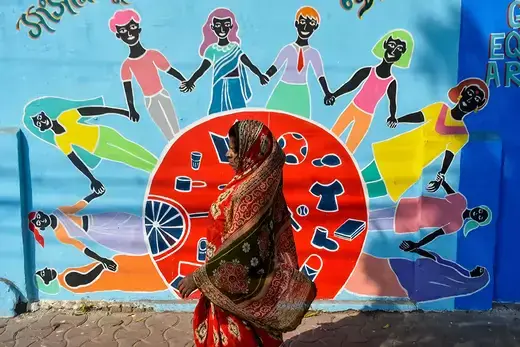In Brief
Progress on the Status of Women and Girls Off Track in UN Assessment
The world’s nations are lagging woefully behind in meeting targets for achieving gender equality by 2030, but a new round of initiatives has stirred hope of progress.
This year’s annual UN General Assembly featured as its centerpiece a two-day summit to evaluate progress toward seventeen Sustainable Development Goals (SDGs). One of those goals, the commitment to achieve gender equality (SDG 5), is considered the single biggest engine for meeting all of the SDGs. Yet, halfway to the SDGs’ deadline of 2030, UN experts say progress toward gender equality has been impeded by legal and institutional barriers, deeply rooted bias, unequal political representation, economic disparities, and lack of legal protection and investment. It will require vigorous new commitments to get on track.
What is the United Nations’ assessment of progress on gender equality?
An assessment [PDF] by UN Women and other UN agencies found that none of the fourteen indicators established for measuring gender equality has been met to date. Only two are close to being met, and the other twelve are “moderately” to “very far” from the meeting the 2030 target. Gender equality is defined in SDG 5 as a fundamental human right for a peaceful, prosperous, and sustainable world. Indicators focus on areas including laws to protect against discrimination and defend legal rights, the incidence of intimate-partner violence, child marriage and female genital mutilation, unpaid care and domestic work, political representation, managerial jobs, health-care and reproductive rights, education, land rights, phone ownership, and government funding and data collection on gender equality.
The assessment also tracks the status of women and girls across the other SDGs and found performance on these goals is off track:
More on:
- SDG 1: While extreme-poverty rates have declined, at the current rate, 340 million women and girls will still live in extreme poverty by 2030.
- SDG 2: One-quarter of women and girls will suffer moderate to severe food insecurity by 2030.
- SDG 3: An estimated 129 million girls are out of school currently, and 110 million will be out of school in 2030.
- SDG 4, 6, 7: Women and girls lack adequate access to health care, water, and housing and will continue to do so in 2030 without faster progress. Of particular concern, progress in reducing maternal mortality has stalled since 2015.
- SDG 8: Women have lower labor participation rates and earn less than men.
- SDG 10: Fifty-four percent of countries still have laws that discriminate against women, and women are twice as likely as men to experience discrimination.
- SDG 12–15: Women are disproportionately affected by the impacts of climate change.
- SDG 16: The number of women living in conflict zones has increased 50 percent since 2017.
- SDG 17: Only 4 percent of bilateral assistance is devoted to reducing gender equality as a principal objective.
Without significantly increased commitment and action, the report concludes, most of these goals will fall short in 2030.
What did member states agree to do to accelerate progress?
As result of the assessment, member states agreed on several steps to accelerate progress, including a featured initiative [PDF] on gender equality that calls for a $1 billion investment. It focuses on eliminating violence against women and girls, which is seen as a core impediment to improving their status. The impact of such violence is estimated at $1.5 trillion annually. The multipronged initiative will be used to significantly scale up efforts by governments and local civil society organizations to remove discriminatory laws, provide services for abused women, pursue legal justice, improve access to health care and economic opportunities, expand women’s participation in leadership and decision-making, invest in educating men and boys on positive masculinity, and raise public awareness about the need for gender equality. While the call for $1 billion to address violence against women and girls is impressive, it does not meet the United Nations’ estimate of funds need to address gender equality in all dimensions—$360 billion per year.
Other commitments made at the summit to accelerate progress across all SDGs could also help advance gender equality. For example, the digital public infrastructure initiative [PDF] aims to give 2.7 billion people access to the internet and reduce online threats that disproportionately affect women and girls, such as gender-based harassment and cyberstalking. This digital initiative calls for the “creation and adoption of [a] universal safeguard framework” to ensure that the digital space is people-centric and protects human rights, including gender-responsive provisions. To ramp up progress on the lagging SDGs, the UN declaration approved by the attendees calls for an increase of $500 billion in annual commitments from member governments. Restructuring international finance to assist low- and middle-income countries is yet another priority for many UN member states looking to mobilize the lower-cost and longer-term investment needed for their development, which would also benefit women and girls.
How would progress on gender equality affect the chances of meeting the other SDGs?
According to the UN assessment, “failure to prioritize SDG 5 will put the entire 2030 Agenda for Sustainable Development in peril.” Because women and girls make up half of the world’s population, failure to address their needs will make it impossible to raise the overall population’s well-being. Raising the status of women and girls will produce wider benefits for all. For example, addressing the growing gender gap in food insecurity will add an estimated $1 trillion to global gross domestic product (GDP), according to the UN assessment. Improving their health, welfare, education, safety, legal rights, and political participation and leadership will enable women and girls to make greater contributions that dramatically advance global peace, stability, and security. Gender equality is thus the single biggest engine for meeting all the SDGs.
More on:
 Online Store
Online Store
